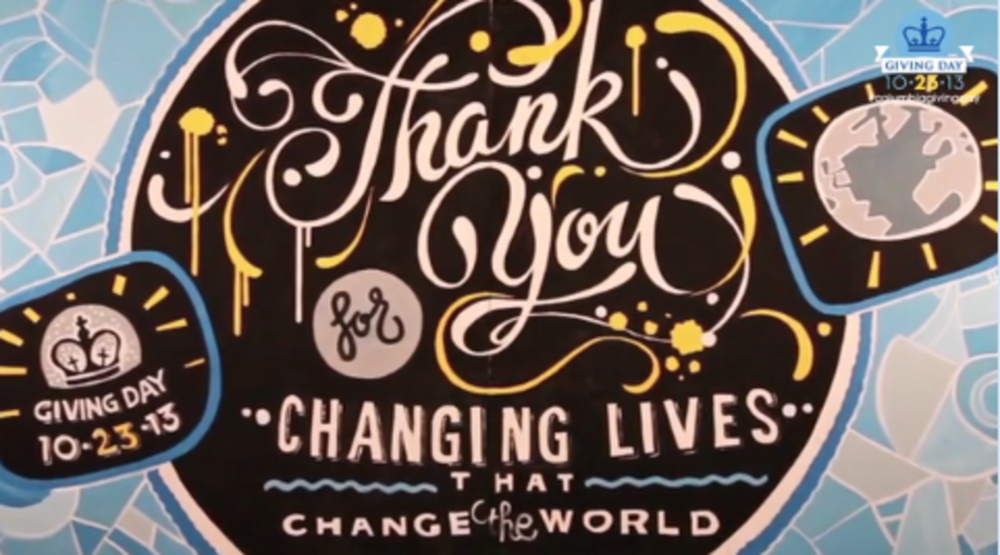The Objective: Universities rely on private donations to survive—and thrive—and Columbia University in New York City is no different. Columbia has always had a loyal core base of alumni willing to contribute large sums to its annual fund, but the university was looking to boost visibility and participation among a wider swath of the post-grad population—a target audience of more than 300,000 university alumni around the world.
“We needed new ways to energize our audience and lift up the impact of annual giving—to put it in the front window of the store, if you will,” says CloEve Demmer, Columbia’s executive director of development programs and operations. “We wanted to engage the masses.”
Demmer and her team realized that they needed a fully integrated marketing plan to pull off what they had in mind: a 24-hour, university-wide online fundraising movement to be called “Giving Day.”
The Strategy: To bring the idea to life, the university applied to digital agency Story Worldwide in 2012 for help developing an engaging gamified experience that would spark sharing and drive revenue.
To make the day fun, but also competitive, all sixteen schools that comprise Columbia University—including the athletics department and the school library—were pitted against each other in friendly contest to see who could bring in the most money for the annual fund. Individual schools could also compete to win a portion of a pool of matching funds put up by Columbia’s Trustees. To keep it fair, matching funds were awarded based on how many alumni participated, rather than the size of the school itself. Funds were tracked on a nearly real-time leader board.
Throughout the day, the schools hosted a variety of live-streamed events and discussions, including a talk hosted by Nobel Laureate and Columbia Professor of Neuroscience Eric Kandel; a deans’ roundtable on globalization; and a debate on the Affordable Care Act between faculty and doctors—all with the aim of demonstrating how alumni dollars are spent, to quote the Giving Day tagline, in the service of “Changing lives that change the world.”
“There was video content, live event support, live tweeting, related content, and audience management throughout to make sure people were commenting and posting,” says Josh Golden, CMO at Story Worldwide. “It was like an endless interactive engagement loop.”
The Creative: To keep the competition fierce, Columbia awarded hourly prizes with any money left over from the matching fund, some serious (a prize for the most donors within an hour) and some silly (a prize for the 23rd most original #ColumbiaGivingDay tweet)—but all in good fun.
The Outreach: Based on data from a recent alumni attitude study, Columbia knew that its alumni are passionate about what’s happening on campus after they graduate, and that they’re also active on social media.
To raise awareness, Columbia created “Giving Day Ambassadors” to spread the word using their personal social clout. Story Worldwide helped Columbia create special Giving Day-related content to distribute to the ambassadors, who were then encouraged to “Recruit your friends and lead the roar!” (Roar, Lion, Roar is the fight song for the Columbia Lions.) Many even turned their Facebook profile picture blue [Columbia’s school color] in the weeks leading up to the Giving Day.
“It’s a model I’ve done successfully with my clients in entertainment and CPG when I used to work in those areas,” says Tim McGowan, Columbia’s deputy VP of alumni and development marketing and communications. “We reached out to those who are the most active talkers.”
Considering that each participating school needed collateral to distribute to its alumni (promo, videos, event support material, educational info, social posts, etc.), Columbia required a lot of content to make Giving Day a success. Story Worldwide worked with Columbia to develop a detailed content calendar and train all faculty and staff on how to use the content to tell their school’s specific story.
“The goal of content marketing is to change user behaviors,” says Story Worldwide’s Golden. “It’s about developing content that creates emotional connections—a narrative based on what the consumer is specifically interested in, and then trying to touch that consumer as they continue along the journey towards taking an action.”
The Results: Columbia raked in more than $7.8 million on October 23, 2013—$1 million more than the previous year. The number of participating donors also increased dramatically to 9,759, nearly double the 2012 total. Not only did the Columbia Alumni Association Facebook page garner more than 10,000 new likes, there also was a 40% conversion-to-donation rate among alumni arriving on the donation site (givingday.columbia.edu) from the Giving Day tab on the association’s Facebook page.
While of course proud of the funds raised, Columbia’s Demmer is particularly happy with the 2013 engagement numbers.
“It’s not just about a dramatic increase in likes; those new Facebook fans are next year’s Giving Day donors,” Demmer says. “This is very much about acquisition, and then next year we can convert the engaged.”






